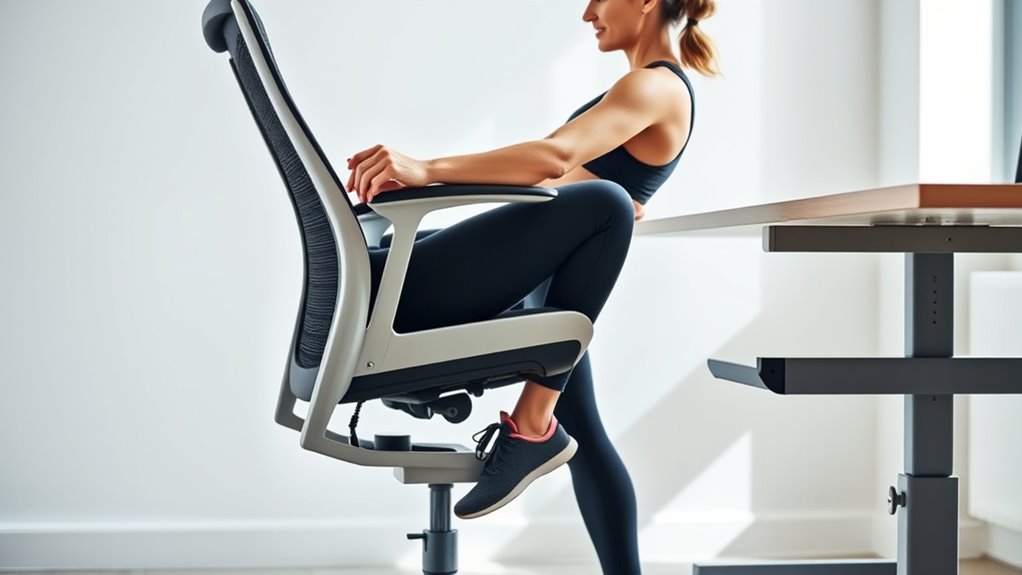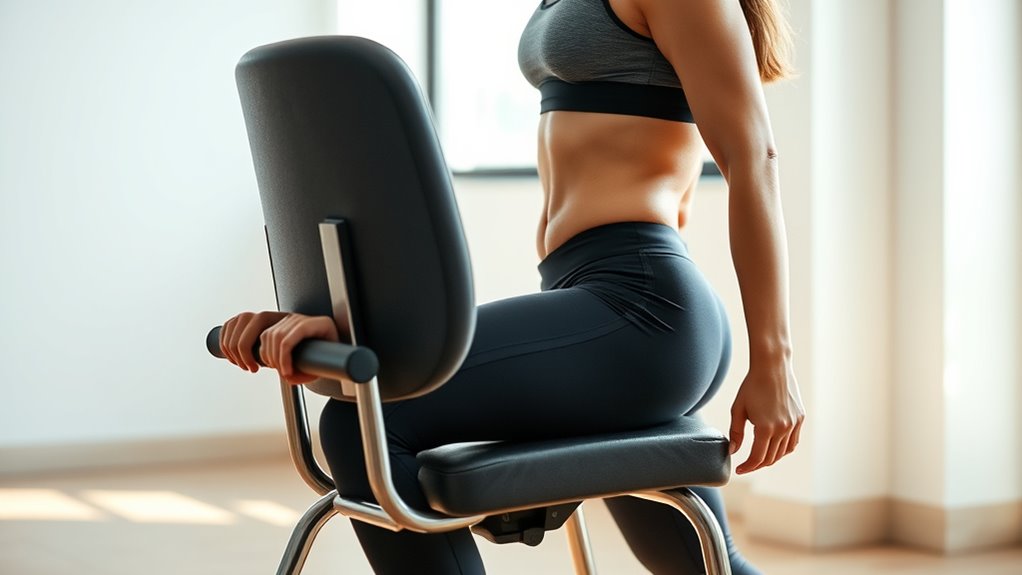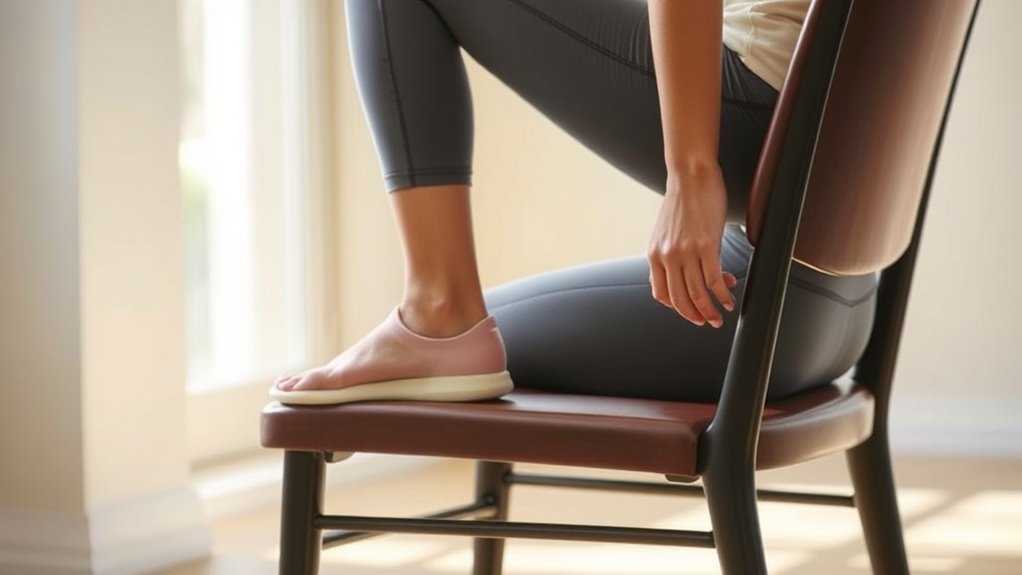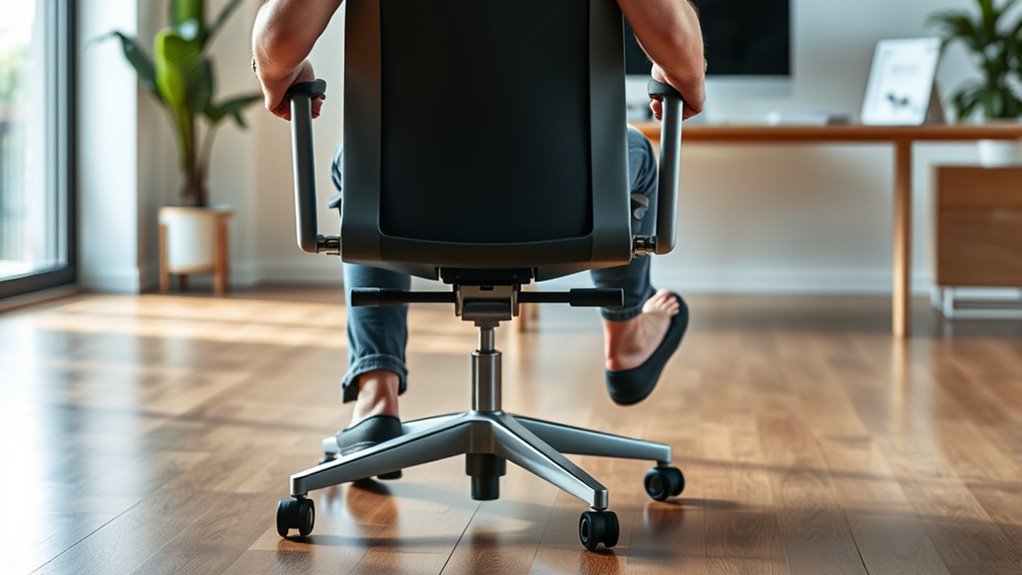To switch smoothly between sitting and standing, prepare your body first by doing gentle stretches and engaging your core muscles for stability. Use support like sturdy chairs or grab bars, and focus on controlled movements to prevent strain. Maintain good posture throughout the progression, moving slowly and deliberately. Building a consistent routine and incorporating proper techniques can make these changes safer and easier. Keep exploring to discover more practical tips for seamless transitions.
Key Takeaways
- Engage core muscles and move slowly to maintain balance during sit-to-stand and stand-to-sit transitions.
- Use sturdy supports like grab bars or stable furniture for added stability.
- Keep feet flat and supported, distributing weight evenly to prevent jerky movements.
- Incorporate gentle stretches and body awareness to prepare muscles for smooth movement.
- Practice controlled, deliberate motions regularly to develop muscle memory and enhance transition safety.
Prepare Your Body Before Moving

Before switching between sitting and standing, it’s important to prepare your body to prevent strain or injury. Start with some pre-move stretching to loosen tight muscles and improve circulation. Focus on gentle stretches for your legs, hips, and back to ease the shift. Mental visualization can also help you prepare mentally; picture yourself moving smoothly and safely, which reduces hesitation and tension. Take a few deep breaths to center yourself and reinforce your intention to move carefully. Incorporating body awareness can further enhance your readiness and control during the transition. By combining pre-move stretching with mental visualization, you’re priming your body and mind for a safe, controlled shift. These simple steps can make a significant difference in preventing discomfort and ensuring your movement is fluid and injury-free.
Use Support to Ease the Transition

Using aid can make switching between sitting and standing much safer and easier. Ergonomic accessories like grab bars or stable chairs provide extra stability as you changeover, reducing the risk of falls or strains. Supportive footwear also plays a key role; shoes with good grip and cushioning help you maintain balance and reduce foot fatigue. When standing up, place your hands on a sturdy surface or use ergonomic accessories designed for assistance. This added stability allows you to shift your weight smoothly and confidently. Remember, support isn’t just about safety—it also helps you conserve energy and avoid unnecessary strain. Incorporating these supports into your routine can make the transition between sitting and standing more comfortable and controlled, promoting better posture and overall well-being. Paying attention to recurring angel numbers can also offer guidance and reassurance during these transitions, fostering a mindful approach to your movement.
Engage Your Core Muscles

Engaging your core muscles provides the stability needed to move smoothly between sitting and standing. When you activate your core, you improve balance and control, making progressions easier and safer. Focus on core activation by tightening your abdominal muscles and engaging your lower back. Incorporate simple stability exercises like planks or pelvic tilts into your routine to strengthen these muscles regularly. Here’s a visual to help you picture the muscles involved:
| Muscles Engaged | Function |
|---|---|
| Abdominals | Stabilize your trunk |
| Lower Back | Support spinal alignment |
| Obliques | Assist with rotational stability |
| Pelvic Floor | Maintain posture and balance |
| Transversus Abdominis | Deep core stabilization |
Consistent core activation makes your progressions more controlled and effortless. Additionally, maintaining proper posture during movements can help prevent strain and injury.
Practice Controlled Movements

Practicing controlled movements is essential for safely shifting between sitting and standing. By focusing on balance awareness, you can better detect your body’s stability during each progression. Engage your muscles intentionally to activate the appropriate groups, such as your core and leg muscles, which helps prevent sudden shifts or loss of balance. Move slowly and deliberately, paying attention to how your muscles coordinate to lift or lower your body. This controlled approach not only improves safety but also enhances your overall movement efficiency. Consistent practice encourages better muscle activation patterns, making transitions smoother and more confident. Over time, you’ll develop a heightened sense of control, reducing the risk of falls or strain during the sit-to-stand or stand-to-sit motions. Incorporating proper technique into your routine ensures safer and more effective movements.
Maintain Proper Posture During Changeovers

Maintaining proper posture during sit-to-stand and stand-to-sit shifts is crucial for preventing strain and ensuring stability. Before moving, make ergonomic adjustments to your workspace or seating setup to support good alignment. Keep your feet flat on the ground, ensuring footwear support provides adequate grip and cushioning. Engage your core muscles to stabilize your spine and avoid leaning forward or hunching your shoulders. As you transition, move smoothly and avoid sudden jerks, keeping your head aligned with your spine. Focus on distributing your weight evenly and maintaining a neutral posture throughout the changeover. Proper posture not only reduces discomfort but also minimizes the risk of injury. Incorporating water resistance can help strengthen your muscles and improve balance during these movements. With consistent practice, these adjustments will help make your sit-to-stand transitions safer and more comfortable.
Incorporate Gentle Stretching

Incorporating gentle stretching into your sit-to-stand routine can considerably enhance flexibility and reduce muscle tension. Start by focusing on your breathing exercises to stay relaxed and centered. As you prepare to stand, take slow, deep breaths, and stretch your arms overhead or gently tilt your neck side to side. Using mindfulness techniques, pay attention to how your muscles feel during each movement, avoiding any strain. Gentle stretches like hamstring or calf stretches can loosen tight muscles and improve circulation. Moving mindfully helps you stay aware of your body’s signals, making progressions smoother and safer. Regularly incorporating warm-up exercises before transitioning can further prepare your muscles and reduce the risk of injury. Incorporate these simple stretches regularly to build awareness and ease muscle stiffness, leading to a more comfortable, fluid switch between sitting and standing.
Build a Routine for Consistent Practice

Creating a routine helps you stay consistent with switching between sitting and standing. Set regular breaks and stick to them, so it becomes a natural part of your day. Keep track of your progress to see how your habits improve over time. Incorporating hydration into your routine can also support your energy levels and overall comfort during these transitions.
Schedule Regular Breaks
To make switching between sitting and standing more effective, it’s essential to set up a routine that includes regular breaks. Consistent breaks help you maintain mental preparedness and prevent fatigue. Use ergonomic accessories to support your posture during shifts. To build this routine:
- Schedule short breaks every 30-60 minutes to stretch and reset.
- Use alarms or timers to remind you to switch positions.
- Incorporate simple stretches to loosen muscles and improve circulation.
- Prepare your workspace to make standing and sitting seamless, reducing resistance to change.
- Consider selecting dog names that reflect your personality or breed, making the transition even more personalized and enjoyable.
Track Your Progress
Have you ever wondered how to stay consistent with your sitting and standing routine? The key is to track your progress by regularly monitoring how often you switch between positions. Use a journal or app to record your daily goals and achievements, making it easier to see your improvements over time. Setting clear, achievable goals helps keep you motivated and focused on building a routine. As you monitor your progress, adjust your targets to challenge yourself without feeling overwhelmed. Celebrating small wins encourages consistency and keeps you on track. Remember, goal setting isn’t just about reaching a specific number but about creating sustainable habits. With consistent progress monitoring, you’ll develop a routine that feels natural and beneficial. Incorporating habit formation techniques can further enhance your ability to stick with your routine over the long term.
Frequently Asked Questions
How Long Should I Pause Between Sitting and Standing?
When shifting from sitting to standing, you should pause for about a second or two. This helps you maintain posture awareness and guarantees you’re engaging your muscles properly. By pausing briefly, you prevent sudden movements that could strain your back or joints. Focus on activating your core and leg muscles before standing fully. This small pause makes the changeover smoother, safer, and more comfortable, especially if you’re recovering from an injury or managing joint issues.
Can Standing Too Quickly Cause Dizziness or Falls?
Imagine you suddenly stand up after sitting too quickly, and dizziness hits. Standing too fast can cause dizziness or falls, especially if your posture correction isn’t solid. To prevent this, do balance exercises regularly and rise slowly. These habits help strengthen your stability, reducing the risk. Always take your time when moving from sitting to standing, so your body can adjust and maintain safe, steady posture.
What Are Signs of Strain During Transitions?
You might notice signs of strain during shifts, like discomfort or muscle fatigue. Pay attention to your posture alignment; if your muscles feel tense or your balance seems off, it’s a sign you’re straining. Dizziness or weakness can also indicate strain. To avoid these issues, move slowly, maintain good posture, and listen to your body. If you experience persistent discomfort, consider consulting a healthcare professional for guidance.
How Often Should I Practice Switching Positions Daily?
Did you know that sitting for over 8 hours daily increases health risks? To stay comfortable, practice shifting positions at least every 30 to 60 minutes. Incorporate ergonomic chair adjustments and stretching exercises into your routine. Regular practice helps your muscles adapt, reduces strain, and makes changes smoother. Aim to change positions frequently, ideally every 30 minutes, to boost circulation and prevent discomfort.
Are There Specific Shoes That Help With Smooth Transitions?
When considering shoes for smooth progressions, ergonomic footwear with supportive insoles can make a big difference. These shoes help stabilize your feet and reduce strain, making it easier to switch from sitting to standing without discomfort. Look for options that provide good arch support, cushioning, and a flexible sole. Wearing the right footwear can improve your balance and make your movements more effortless during these position changes.
Conclusion
Switching between sitting and standing becomes easier when you prepare your body and take it slow. Remember, practice makes perfect, so don’t rush the process. By maintaining proper posture and engaging your muscles, you’ll build confidence and avoid discomfort. Think of it as breaking the ice—you’ll get better with each attempt. Keep consistent, stay mindful, and soon this shift will feel second nature. With patience and persistence, you’ll be on your way to a healthier, more balanced routine.









